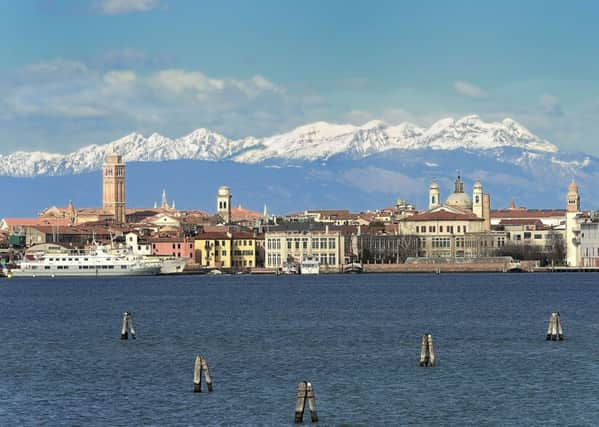Travel review: Rebirth in Venice


Famous for being sticky, sweaty and (some might even cruelly claim) smelly during the height of summer, Venice is rarely relieved by a cool breeze. That probably explains why Isola delle Rose, a 16-hectare island south of San Marco, has always been known to Venetians as a jewel in the lagoon.
With temperatures teetering at a lethargy-inducing 31C, I welcome the salty Adriatic sea breeze billowing the muslin drapes on my rooftop daybed. Operating as a sanatorium in the 1920s, the island offered recuperation to patients with pulmonary diseases. The hospital has since been replaced with a hotel, although rest and recuperation are still high on the agenda.
Advertisement
Hide AdAdvertisement
Hide AdMade from the sand and soil dug out during the construction of the city’s commercial port, Isola delle Rose is one of 35 islands in the Venetian Lagoon. While tourist hotspots such as Burano (famous for it’s colourful fishermen’s houses) and Murano (home to a world-renowned glass-blowing industry) are firmly on the map, other islands – once used to isolate plague victims or even as lunatic asylums – have been forgotten.
Hoteliers, though, are starting to realise a hitherto missed opportunity; in 2014 the Starwood group relaunched the five-star property on Isola di San Clemente and in March this year, Marriott opened their swish summer resort on Isola delle Rose. Operating from March to October, the hotel consumes the peaceful green grounds where century-old olive groves – quite unheard of this far north - flourish, thanks to the unique microclimate.
There are several seasonal hotels in Venice but this is a different concept; an escape from the summer madness that besets the city as cruise liners deposit hordes of tourists in the narrow, labyrinthine streets.
While lazing with a Bellini (try the hotel’s twist on the classic cocktail, made with Ruinart champagne and fresh white peach) in the rooftop infinity pool, I enjoy a clear, crowd-free view of Venice, or La Serenissima to locals. I’m told it’s even possible to see the faint outline of the Alps on a good day.
Advertisement
Hide AdAdvertisement
Hide AdIt took 350 workers four years to complete the 250-room hotel, restoring original 19th century buildings wherever possible. I stay in the main wing, with cool, neutral interiors, designed by Milan-based Matteo Thun. A conveyor belt of visitors churns through the busy reception area – which at times feels even more manic than San Marco – but quirky touches, such as giant glass jars filled with complimentary jelly sweets, save the former hospital from feeling too clinical.
Outside the main building, several grain stores have been converted into garden villas, with private pools and trellises of fragrant jasmine. A pre-Romanesque church, although not consecrated, is available for event use, and an industrial water tower looks all-too-tempting to climb. Although a frustrating inconvenience for hotel planners, this protected piece of the Venetian skyline is, to my mind, a defining feature of Isola delle Rose.
I wander through the shady 19th century gardens, landscaped to an original design, listening to birdsong. When the hospital closed in the 1970s, the island was abandoned for decades, and the overgrown linden forests became a favourite picnic spot for Venetians sneaking here in private boats.
Today, they can still moor up alongside the hotel, although the food now on offer is of a much higher standard. Presided over by Michelin-starred chef Gianfranco Perbellini, the gourmet Dopolavoro restaurant is well worth the 20-minute boat ride from Venice, even if you’re not staying at the hotel.
Advertisement
Hide AdAdvertisement
Hide AdOnce used as a social space by hospital workers (even the name, which means ‘after work’, is borrowed), the moody, mirror-filled restaurant is stirring up Venice’s somewhat stale culinary scene with creative dishes such as zabaglione topped with caviar, and a pork belly so tender I almost mistake it for a tuna steak.
There are three other restaurants to dine in: breakfast bar Cucina; relaxed Sagra, serving a rotating menu of regional cuisine; and al fresco grill, Giardino.
At the onsite Sapori Cooking Academy, I spend the afternoon with unfalteringly patient chef Matteo, learning the secret to a good tiramisu lies in a vat of mascarpone equivalent to a woman’s annual calorie count. Yet I still order the caffeine-kick dish (which Venetians like to claim as their own) for dessert. Twice a day.
Besides, there’s plenty opportunity to burn off creamy fat in the gym, or cheat with a body contouring treatment at the GOCO garden spa, the largest in Venice with its sauna, steam room and a hydro-pool looking out to the lagoon. (Access to facilities costs an extra 25 euros.)
Advertisement
Hide AdAdvertisement
Hide AdI try a QMS facial (169 euros), where oxygen is blasted into my skin, stamping pesky crows’ feet into submission, although less invasive treatments are available with the organic AMALA range.
While Isola delle Rose’s trump card is its separation from Venice, it’s also the hotel’s main drawback. A regular 20-minute shuttle service runs to San Marco until 1am, but the 9am start is a little too late to avoid heaving crowds.
But while Venice first-timers might prefer to be in the thick of the action, returning visitors will relish a chance to weave beyond bricole poles and delve further into the salt marshes, discovering new jewels in the regal city’s crown.
GETTING THERE
Sarah Marshall was a guest of the JW Marriott Venice (www.jwmarriottvenice.com) where rooms cost from 395 euros per night, including breakfast.
Monarch Airlines fly to Venice Marco Polo from Birmingham, London and Manchester from £66 return.